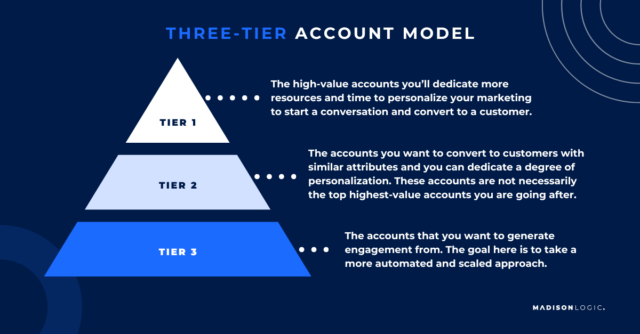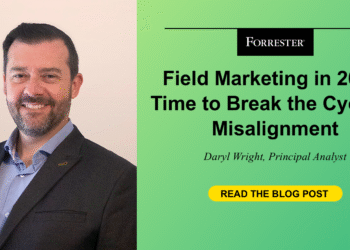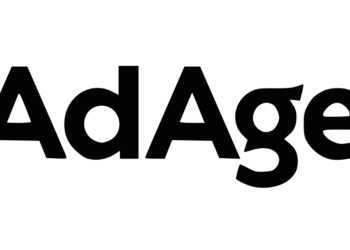Too many B2B websites still operate like static brochures—same message, same call-to-action (CTA), regardless of who’s visiting. Yet modern buyers don’t just want relevance—they expect it. 71% of B2B buyers report feeling frustrated when digital experiences aren’t personalized to their needs, resulting in loss of trust, time, and often, the deal.
Web personalization isn’t just a UX upgrade. It’s a strategic advantage that aligns your digital presence with who your audience is and what they are looking for. In a world where account-based marketing (ABM) has raised the bar for targeted engagement, a one-size-fits-all website experience doesn’t just fall flat—it creates disconnect.
So why do so many brands still hesitate? Concerns about tech complexity, privacy, and scalability often get in the way. Others confuse personalization with surface-level tactics like swapping in a company name. But when done right, real website personalization becomes one of your most powerful levers to drive pipeline, build brand credibility, improve brand recall, and create the kind of connection that static pages simply can’t deliver.
In this article, we’ll break down what true web personalization looks like in a B2B context, how to put it into action in your ABM strategy, and how to avoid common pitfalls while measuring what really matters.
What Is Web Personalization?
Web personalization is the practice of dynamically adapting your website content based on who’s visiting—whether that’s by their company, role, industry, or previous interactions. Instead of giving the same experience to every visitor, personalization delivers messaging, offers, and content that reflect what the buyer cares about and where they are in their journey.
The result? A more relevant, engaging experience that keeps visitors on your site longer and leaves a stronger impression of your brand. When your target accounts see content that speaks directly to their needs, they’re more likely to trust your brand—and that trust increases the likelihood of conversion.
How It Works in B2B vs. B2C
In B2C, web personalization is driven by individual behaviors, such as past purchases, search history, or items left in a cart. Think of how Amazon recommends products based on your shopping activity, or how Netflix curates content based on your viewing habits. These experiences are designed to feel seamless, intuitive, and uniquely tailored to each consumer.
B2B personalization, historically, has looked different. It’s often based on firmographic data—things like industry, company size, and job function to segment site visitors into broad groups. For example, a visitor from a manufacturing company sees a different homepage message than someone from a financial services firm. While this type of account-level targeting was once a breakthrough, today’s B2B buyers expect more.
Modern B2B personalization goes beyond static segmentation. It dynamically adapts content to reflect a visitor’s specific role, intent signals, and stage in the buying journey—often across multiple members of a buying group.
For instance, an IT director evaluating technical fit might see technical specs or integration guides, while a CFO from the same account is served return on investment (ROI) calculators and budget justification content. This level of personalization demonstrates that you understand each stakeholder’s priorities and helps keep your solution top of mind when it matters the most.
Real-Time vs. Rule-Based Personalization
There are two main approaches to web personalization: real-time and rule-based.
Real-time personalization uses machine learning to adapt content instantly based on a visitor’s current behavior, preferences, or intent signals. As users navigate your site, the experience evolves—surfacing the most relevant content, recommendations, or messages in the moment. This makes it ideal for dynamic buying journeys where visitors’ needs can shift quickly.
Rule-based personalization follows predefined “if-this-then-that” logic. For example, a visitor from the healthcare industry might see different messaging than someone from financial services, regardless of how they interact with the site. It’s more static but easier to set up and manage, giving marketers full control over what’s shown and when.
While real-time personalization offers adaptability and scale, rule-based approaches provide simplicity and predictability. The right fit depends on your goals, available data, and how sophisticated your personalization strategy needs to be.
Why Web Personalization Matters for Your Brand
In B2B, web personalization isn’t just a nice-to-have—it’s essential for engaging today’s large, self-directed buying groups. Every visit to your site is an opportunity to build trust, deliver tailored value, and move buyers closer to a decision. By making each interaction more relevant, personalization helps turn anonymous traffic into high-intent opportunities.
Better Engagement Through Relevance
Personalization ensures your content aligns with buyer personas, roles, and buying stage in the buying journey—whether that means surfacing relevant use cases or guiding the next best action. Today’s B2B buyers—especially Gen Z and millennial buyers aged 25-44—expect self-directed, curated experiences that reflect their needs.
With Gartner finding that 75% of buyers spend little to no time with sales reps, your website must step up as your best-performing seller. Personalization not only extends engagement time—it builds stronger connections and accelerates the path to conversion by making every visit feel purposeful.
Brand Recall in Competitive Markets
In crowded B2B categories, personalization helps your brand break through the noise. According to LinkedIn, 56% of tech buyers prefer to buy from established vendors, making trust and familiarity critical. Personalized web experiences foster that trust by showing visitors that you understand their world and speak to their priorities.
This level of targeted relevance also helps you gain mindshare in accounts that may not be actively buying, as decision-makers and priorities constantly shift. Whether you’re trying to displace a competitor or get on the radar for future consideration, personalized content helps you plant the seed that your solution is the better fit. Over time, these tailored interactions build brand recall, loyalty, and a stronger competitive edge.
Impact on Conversion and Sales Cycles
Web personalization accelerates the sales cycle by delivering the right information and tools to the right stakeholders at the right time—helping them make confident decisions faster. Early in the journey, personalized elements like industry-specific case studies and social proof build credibility. As the account moves forward, tailored solution overviews and product-related content address role-specific pain points, reducing friction and research time. Further down the funnel, interactive tools like ROI calculators and cost-benefit assessments empower buyers to make confident, informed decisions that help sales teams close deals faster and with greater impact.
Aligning Web Personalization with ABM
Web personalization is a natural—and powerful—extension of your ABM strategy. It translates your rich account insights into dynamic, tailored website experiences that resonate with every visitor from your target account list.
By using the same data that powers your ABM campaigns—firmographics, engagement history, intent data, and buying stage details—you can move beyond a one-size-fits-all website. You will deliver personalized content, messaging, and CTAs based on who the visitor is, what they care about, and where they are in the buying journey.
For example, a returning healthcare CIO might be shown security-specific case studies, while a first-time visitor from the same account sees high-level solution benefits designed for early-stage awareness. These types of adaptive experiences make your site feel instantly relevant and deepen engagement with your most valuable accounts.
Two ABM practices help implement web personalization at scale: structuring your personalization approach around your ABM account tiers and integrating data to understand your buyers and their journey.
Personalizing by Tiered Accounts
In ABM, not all accounts require the same level of attention, so your personalization strategy shouldn’t treat them equally. A tiered personalization approach helps scale your efforts efficiently while still delivering impact across your target account list:
- Tier 1 (High-Touch Accounts): Build fully customized landing pages or site experiences. Include welcome messages with company names, tailored product messaging, curated content hubs, and use case-specific assets aligned to the visitor’s role and buying journey stage.
- Tier 2 (Mid-Tier Accounts): Use scalable personalization tactics such as dynamic banners, role-specific CTAs, or industry-based case studies. Templates and rules help deliver relevance while keeping production efficient.
- Tier 3 (Broader Target Pool): Lightweight personalization still makes an impact. Tactics like geo-targeted messaging or general vertical-focused content can enhance relevance without straining resources.

This approach ensures your personalization efforts stay aligned with account value—maximizing both impact and efficiency.
Connecting CRM & Intent Data for Dynamic Experiences
Your customer relationship management (CRM) and intent data sources are critical for driving dynamic web experiences that stay coordinated with buyer behavior.
- CRM integration enables you to identify known visitors and tailor the web experience based on opportunity stage, deal progression, or past engagement. For example, if a decision-maker from an open opportunity visits your site, you can serve late-stage content like ROI tools and competitive comparisons to move them closer to a decision.
- Intent data reveals what your target accounts are researching elsewhere—even before they engage with you directly. If an account is actively researching a competitor or a key solution category, your site can prioritize related case studies, pain-point-driven messaging, or urgency-focused content.
Together, these data sources allow you to create a responsive, high-impact web experience—one that not only aligns with your ABM strategy but strengthens it by delivering personalized value at every touchpoint.
Common Challenges in Web Personalization
If website personalization were easy, everyone would be doing it—and it wouldn’t serve as the powerful differentiator it is today. According to Gartner, 63% of marketing leaders struggle to execute effective personalization in a digital marketing strategy. Personalization goals are met with challenges like data management, scalability, and navigating a complex data privacy landscape.
The good news? With the right technology and strategy, these challenges are solved. Web personalization’s success hinges on a strong data foundation, scalable content frameworks, and responsible, trust-centric practices.
Data Quality and Siloed Systems
The biggest barrier to effective personalization is fragmented or incomplete data. Without clean, unified buyer insights, personalization misses the mark—or worse, creates a disjoined user experience.
The Fix: Integrate data from your CRM, marketing automation platform (MAP), intent data providers, and content engagement systems into a single, cohesive view. When your website pulls from accurate, centralized data, it can dynamically respond to each visitor with timely, relevant content—delivered in real time.
Content Scalability
Website personalization goes beyond tagging personas to content—it requires delivering the right message, in the right format, at the right time. This often means creating multiple variations of headlines, CTAs, product descriptions, and assets tailored by industry, role, and buying stage. Without a plan, this content demand can quickly become overwhelming.
The Fix: Shift to a modular content strategy. Build reusable assets and flexible components that can be repurposed and adapted across different audiences and use cases. For example, a customer success story can be restructured for different industries with only minor copy adjustments.
AI for ABM tools further simplify this by helping you rewrite content by persona, adapt messaging for different verticals, or scale product descriptions by account tier. Just remember—AI should support your creative strategy, not replace it. Use it to accelerate production while grounding output in real buyer insight.
Trust, Privacy and Compliance
Buyers today are more privacy-conscious than ever—and regulations like General Data Protection Regulation (GDPR), California Consumer Privacy Act (CCPA), and Canada’s Anti-Spam Legislation (CASL) have only raised the stakes. Brands that fail to balance personalization with data protection risk losing trust and facing steep penalties.
The Fix: Build your personalization strategies on privacy-safe, compliant data and opt-in intent signals. Use transparent data policies, consent management tools, and secure data handling practices to ensure compliance. Leverage anonymized personalization where possible, and give users control over their experience. When visitors understand how their data is used—and feel it’s handled responsibly—they’re more likely to engage and stay loyal to your brand.
In short, web personalization isn’t without its challenges but overcoming them is what turns good marketing into great marketing. With the right foundation in place, personalization becomes a scalable, compliant, and highly impactful growth lever.
Best Practices for Scalable Personalization
Scaling web personalization in ABM isn’t just about having more content—it’s about building smarter, modular systems that allow you to deliver meaningful, relevant experiences without overloading your team or tech stack. The most successful strategies combine flexible content design, data-driven automation, and precise targeting.
These best practices help make personalization operational, measurable, and repeatable—so your web strategy becomes a consistent engine for engagement and pipeline growth.
Modular Content Design
The foundation of scalable web personalization is modular content—breaking down larger assets into flexible, reusable components that can be dynamically assembled based on who’s visiting.
Here’s what that looks like in practice:
- Headline Variants: Create multiple versions of headlines tailored by industry, persona, or buying stage, stored within your content management system (CMS) for dynamic delivery.
- CTA Blocks: Build a library of CTAs written for awareness, consideration, and decision stages—allowing you to serve the right prompt based on behavioral triggers.
- Pain Point Messaging: Write modular value propositions that speak directly to specific job functions or challenges (e.g., IT security for CIOs, cost reduction for finance, agility for operations).
- Use Customer Testimonials: Collect customer quotes and case study snippets tagged by vertical or product application, so you can surface the most relevant social proof in real time.
Rather than building entirely new pages for every segment, start by creating core content frameworks that adapt to your target accounts. For example, instead of creating three separate case studies for healthcare, retail, and manufacturing, write one core narrative and modularize the intro, supporting stats, and client pull quotes per industry. This approach significantly reduces duplication, speeds up production, and allows for easier personalization across your site.
Modular Content Design Checklist
Use this checklist to assess whether your content is built for modular web personalization:
Structure & Planning
- Have you identified your priority segments (e.g., industry, role, funnel stage) and account tiers?
- Are core assets broken into smaller, reusable blocks of content?
Tagging & Taxonomy
- Are all content blocks tagged with metadata (persona, industry, stage)?
- Are tags aligned across your CMS, CRM, and personalization tools?
Content Creation
- Do you have multiple headline, CTA, and value prop variants for each segment?
- Is your copy flexible enough to mix and match without losing value by segment?
System & Delivery
- Is your CMS or personalization platform set up to pull content dynamically by tag?
- Do your personalized pages look cohesive and natural when assembled?
Optimization
- Are you AB Testing or tracking the performance of individual content blocks (e.g., CTA version A vs. CTA version B)?
- Do you have a process or cadence for refreshing or expanding blocks based on gaps or engagement data?
Behavioral & Firmographic Targeting
Scalable web personalization starts with targeting the right people in the right way. By combining behavioral and firmographic data, you can create highly relevant, dynamic experiences for both accounts and individuals that align with your ABM strategies.
Firmographic Targeting
Firmographic data provides a structured foundation for personalization. It includes company-level traits like:
- Industry
- Company size
- Revenue
- Location
- Tech stack
With this data, your website can automatically adjust messaging, value props, and content. For example, enterprise healthcare accounts might see messaging about scalability and compliance, while mid-market SaaS firms get speed-to-value positioning.
Behavioral Targeting
Behavioral data brings real-time context to the table by tracking:
- Page views
- Content downloads
- Scroll depth
- Return visits
You can use this data to deliver more relevant CTAs (e.g., showing a “Book a Demo” button to a returning visitor) or surface content based on the journey stage (e.g., “ROI Calculator” after viewing a product page).
Together, these targeting types create a dual lens—firmographics tell you who the visitor is, and behavior tells you what they care about now.
Measuring What Matters
Web personalization should drive impact, not just activity. To measure its value, you need to connect your personalization efforts to both engagement signals and pipeline results.
Engagement Metrics That Signal Relevance
Pro Tip: Use A/B testing to evaluate how personalized pages perform against generic versions.
Funnel Progression Metrics That Show Intent
Pro Tip: Set benchmarks for return visits. Personalized experiences should drive repeat engagement and faster progression.
Pro Tip: Integrate web analytics with your CRM or MAP to trace visitor behavior to opportunity creation.
Qualitative Feedback That Validates Relevance
Pro Tip: Use feedback loops for greater sales and marketing alignment and to adjust personalization tactics based on real conversations and buyer sentiment.
Examples of Web Personalization in Action
Seeing how others do web personalization makes your strategy more practical and repeatable. Below are three examples showing how B2B marketers are scaling personalized web experiences—successfully and strategically.
Mid-Funnel Nurturing Pages
Tailoring mid-funnel content by persona helps reduce bounce rates and move decision-makers closer to conversion.
- Use Case: A B2B software company needed to engage different buyer personas mid-funnel.
- Tactic: Built a dynamic content hub that adapted based on firmographic data—serving different messaging, case studies, and CTAs for IT leaders vs. marketing executives.
- Result: Higher time on page, lower bounce rates, and an uptick in demo requests.
Personalized Resource Hubs
Adapting your site experience based on intent data creates more relevant content journeys and faster buying decisions.
- Use Case: A cybersecurity company wanted to accelerate buyer journeys with real-time relevance.
- Tactic: Leveraged third-party intent data to dynamically surface content aligned to trending topics (e.g., “data loss prevention”) based on what the visitor was researching.
- Result: Increased content engagement and a measurable reduction in time-to-conversion.
ABM Landing Pages by Industry
Industry-specific ABM landing pages boost relevance and drive more qualified interactions.
- Use Case: A B2B tech brand running high-touch ABM campaigns wanted to increase industry-resonance.
- Tactic: Developed tailored landing pages for healthcare, finance, and manufacturing—each with unique messaging, visuals, use cases, customer proof, and CTAs.
- Result: Boosted sales interactions and conversion rates from key verticals.
How Madison Logic Helps Align Web Personalization with a Full-Funnel ABM Strategy
Your website is always on—but buyers aren’t always there. They’re researching solutions across multiple channels, from display advertising, content syndication, LinkedIn, and increasingly, newer formats like Connected TV (CTV) and audio advertising. That’s why effective personalization doesn’t stop at the homepage. It must extend across every touchpoint your audience encounters on your paid and owned channels, creating a seamless and connected buyer journey no matter where or when they engage.
Website personalization plays a central role in delivering this unified experience. But to work at scale, it must be fueled by quality, connected, and actionable data. That’s where Madison Logic comes in.
With ML Insights, our proprietary intent data solution, you can personalize your website and campaigns using the same high-value signals already powering your ABM strategy. From firmographics and buying stage to trending intent topics, ML Insights helps you tailor every interaction across your marketing ecosystem—including your website.
From Website to Full-Funnel ABM
Your web personalization strategy should be the heartbeat of your ABM efforts—not an isolated tactic. With Madison Logic, you can extend your data-driven strategy across every campaign, every persona, and every channel.
Start transforming anonymous interest into active pipeline by aligning your web experience with your entire demand strategy. Contact us to explore how Madison Logic can help you deliver personalized, full-funnel ABM that turns engagement into opportunity.















